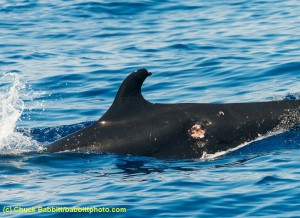DLNR Recognizes Whale Responders
A man who assisted in the transport of a well-known 1,300-pound false killer whale body on the Big Island in November, along with a specialist with the Department of Land and Natural Resources Division of Aquatic Resources, are being applauded for their efforts in the transport.
The Big Island resident, Rodney Kuahiwinui, spotted the body of the dead whale and called DAR’s John Kahiapo in early November.
Text messages and images of the whale allowed marine mammal experts to identify the whale as a highly endangered false killer whale who had been studied and sighted eight times off the coast of Oahu and the Big Island after being first documented in 2004.
HIPc198, the official named of the stranded whale, was determined to have died from abnormal blood clot formations in the heart and lungs.
Kuahiwinui, who raises cattle on Hawaiian Home Lands, owned heavy equipment necessary for the transport, according to DLNR officials. He offered to help in the situation as a supporting community member.
“Today we are fortunate enough to see whales traveling in the area,” said Kuahiwinui. “We have to do everything we can to help make sure they are still here for future generations.”
Using an engine hoist, he lifted the animal and placed it onto his flatbed truck and made the four-hour journey to Kona, where the whale was taken from his care and transported via Transair to Honolulu for examination and an endocropsy.
“Without the unwavering efforts of Rodney and John, we would not have been able to find out why this animal died,” said Dr. Kristi West, head of Hawai’i Pacific University’s stranding program. “From my perspective, they really are heroes.”
There have been only three Hawaiian false killer whale reports of strandings in the past 18 years.
“With less than 200 individuals alive today, every piece of information is critical,” says Dr. West. “If we want to understand the threats facing these animals, we need the public’s help.”
In efforts to provide additional government support for the conservation and recovery of Hawai’i’s endangered false killer whales, the DLNR was awarded nearly $1.2 million from the federal government in September.
Anyone who spots a dolphin or a whale stranded on the beach or close to shore should call 1-888-256-9840.















